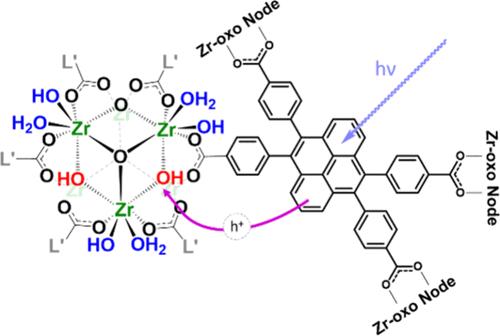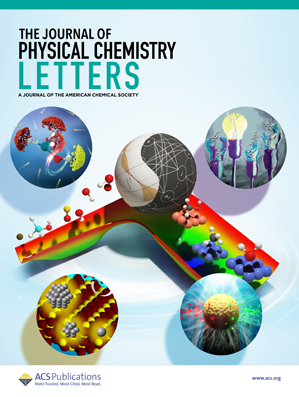Unexpected Photodriven Linker-to-Node Hole Transfer in a Zirconium-Based Metal–Organic Framework
IF 4.8
2区 化学
Q2 CHEMISTRY, PHYSICAL
引用次数: 0
Abstract
Zr6(μ3-O)4(μ3-OH)4 node cores are indispensable building blocks for almost all zirconium-based metal–organic frameworks. Consistent with the insulating nature of zirconia, they are generally considered electronically inert. Contrasting this viewpoint, we present spectral measurements and calculations indicating that emission from photoexcited NU-601, a six-connected Zr-based MOF, comes from both linker-centric locally excited and linker-to-node charge-transfer (CT) states. The CT state originates from a hole transfer process enabled by favorable energy alignment of the HOMOs of the node and linker. This alignment can be manipulated by changing the pH of the medium, which alters the protonation state of multiple oxy groups on the Zr-node. Thus, the acid–base chemistry of the node has a direct effect on the photophysics of the MOF following linker-localized electronic excitation. These new findings open opportunities to understand and exploit, for energy conversion, unconventional mechanisms of exciton formation and transport in MOFs.

锆基金属有机框架中意想不到的光驱动链节间空穴传输
Zr6(μ3-O)4(μ3-OH)4节点核心是几乎所有锆基金属有机框架不可或缺的构建模块。与氧化锆的绝缘性质相一致,它们通常被认为是电子惰性的。与这一观点相反,我们进行的光谱测量和计算表明,光激发 NU-601 (一种六连通的锆基 MOF)的发射来自以连接体为中心的局部激发态和连接体到节点的电荷转移 (CT) 态。CT 状态源于节点和连接体的 HOMO 的有利能量排列所促成的空穴传输过程。这种排列可以通过改变介质的 pH 值来实现,而介质的 pH 值会改变 Zr 节点上多个氧基团的质子化状态。因此,节点的酸碱化学性质会直接影响连接体定位电子激发后 MOF 的光物理学特性。这些新发现为了解和利用 MOF 中激子形成和传输的非常规机制进行能量转换提供了机会。
本文章由计算机程序翻译,如有差异,请以英文原文为准。
求助全文
约1分钟内获得全文
求助全文
来源期刊

The Journal of Physical Chemistry Letters
CHEMISTRY, PHYSICAL-NANOSCIENCE & NANOTECHNOLOGY
CiteScore
9.60
自引率
7.00%
发文量
1519
审稿时长
1.6 months
期刊介绍:
The Journal of Physical Chemistry (JPC) Letters is devoted to reporting new and original experimental and theoretical basic research of interest to physical chemists, biophysical chemists, chemical physicists, physicists, material scientists, and engineers. An important criterion for acceptance is that the paper reports a significant scientific advance and/or physical insight such that rapid publication is essential. Two issues of JPC Letters are published each month.
 求助内容:
求助内容: 应助结果提醒方式:
应助结果提醒方式:


